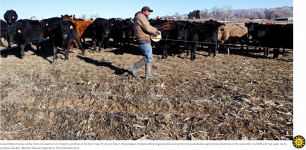Linda Poole
NCAT Regenerative Grazing Specialist
In this article by Chris Outcalt in the Colorado Sun, meet regenerative rancher Lowell King. He's got a cautionary, and at the same time inspiring, story to tell about the importance of capturing and holding more water in soils:

On his way to embracing this style of farming, King has become something of a self-taught dirt guru. He has a sticker on the back of his truck that reads: “I dig healthy soil.” Several years ago, King heard a North Dakota farmer give a talk at a soil conference about the basic tenets of regenerative ag, which prioritizes limiting any disturbance to the soil as a means to improve the health and yield of a crop. That presentation led King to radically change the way he farms his 300 acres of hay, small grains, non-GMO corn, and cover crops. At first, King was driven by a desire to improve his bottom line, saving on labor and fuel costs and wear and tear on equipment. “At the end of the day, we’re doing this for a living,” King says. But as he began to alter the way he farmed, King found there were other benefits. Most notably, in a state gripped by a punishing, decades-long drought, where every drop of moisture is akin to a rare jewel, King realized he was using less water.
King farmed for 10 years using the same conventional methods as everyone else. After he attended the soil health conference, though, he started to make some changes in 2016. One of the things about that presentation that sticks with King today is that the farmer from North Dakota got very emotional when talking about water. “He said, ‘you guys have all the water you want and so you don’t think you need to conserve water,’” King said. “But he said ‘it’s not going to always be that way.’ And that was before there was so much talk about the water situation in the Southwest.”
That time is now. King uses water from the Colorado River to irrigate his fields. A canal system delivers it to his farm. King is one of about 40 million people in seven states that rely on the water in that river one way or another. When it comes to agriculture, farmers and ranchers use water from the Colorado River to irrigate more than 3 million acres of farmland.
In 2018, King sold $200,000 of tillage equipment and went all in on no-till and planting rotational cover crops. He said the results have been exceptional. “What I can tell you is that every year I do this, the amount of water I meter is decreasing and we’re growing more crops — we can actually increase production.”
King is quick to admit that he’s not a politician and has no interest in getting involved in politics. But he does see a potential solution here. When King hears about proposals to save water by drying up farmland — buy-and-dry in ag parlance — he thinks why can’t we just be more water efficient instead? Rather than paying farmers to let a field sit fallow, King said, why not pay them to plant cover crops that use less water.
“The thing that really frustrates me about that is that part of the solution to the water problem is to improve soil health,” he said. “And when you take land out of production and let it sit fallow with nothing growing, that is one of the worst things possible for soil health.”





